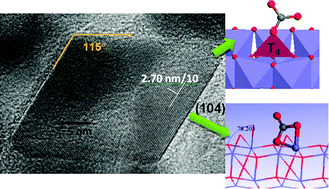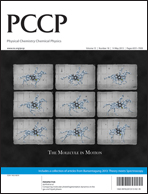Linking interfacial chemistry of CO2 to surface structures of hydrated metal oxide nanoparticles: hematite†
Abstract
A better understanding of interaction with dissolved CO2 is required to rationally design and model the (photo)catalytic and sorption processes on metal (hydr)oxide nanoparticles (NPs) in aqueous media. Using in situ FTIR spectroscopy, we address this problem for rhombohedral 38 nm hematite (α-Fe2O3) nanoparticles as a model. We not only resolve the structures of the adsorbed carbonate species, but also specify their adsorption sites and their location on the nanoparticle surface. The spectral relationships obtained present a basis for a new method of characterizing the microscopic structural and acid–base properties (related to individual adsorption sites) of hydrated metal (hydr)oxide NPs using atmospherically derived CO2 as a probe. Specifically, we distinguish two carbonate species suggesting two principally different adsorption mechanisms. One species, which is more weakly adsorbed, has an inner-sphere mononuclear monodentate structure which is formed by a conventional ligand-exchange mechanism. At natural levels of dissolved carbonate and pH from 3 to 11, this species is attached to the most acidic/reactive surface cations (surface states) associated with ferrihydrite-like surface defects. The second species, which is more strongly adsorbed, presents a mixed C and O coordination of bent CO2. This species uniquely recognizes the stoichiometric rhombohedral {104} facets in the NP texture. Like in gas phase, it is formed through the surface coordination of molecular CO2. We address how the adsorption sites hosting these two carbonate species are affected by the annealing and acid etching of the NPs. These results support the nanosize-induced phase transformation of hematite towards ferrihydrite under hydrous conditions, and additionally show that the process starts from the roughened areas of the facet intersections.


 Please wait while we load your content...
Please wait while we load your content...